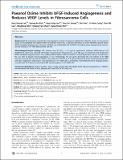| dc.contributor.author | Lee, Hyo-Jeong | |
| dc.contributor.author | Kim, Seung-Ae | |
| dc.contributor.author | Lee, Hyo-Jung | |
| dc.contributor.author | Jeong, Soo-Jin | |
| dc.contributor.author | Han, Ihn | |
| dc.contributor.author | Lee, Eun-Ok | |
| dc.contributor.author | Kim, Sung-Hoon | |
| dc.contributor.author | Jung, Ji Hoon | |
| dc.contributor.author | Zhu, Shudong | |
| dc.contributor.author | Chen, Chang-Yan | |
| dc.date.accessioned | 2011-04-27T02:38:12Z | |
| dc.date.issued | 2010 | |
| dc.identifier.citation | Lee, Hyo-Jeong, Seung-Ae Kim, Hyo-Jung Lee, Soo-Jin Jeong, Ihn Han, Ji Hoon Jung, Eun-Ok Lee, Shudong Zhu, Chang-Yan Chen, and Sung-Hoon Kim. 2010. Paeonol oxime inhibits bFGF-induced angiogenesis and reduces VEGF levels in fibrosarcoma cells. PLoS ONE 5(8): e12358. | en_US |
| dc.identifier.issn | 1932-6203 | en_US |
| dc.identifier.uri | http://nrs.harvard.edu/urn-3:HUL.InstRepos:4878071 | |
| dc.description.abstract | Background: We previously reported the anti-angiogenic activity of paeonol isolated from Moutan Cortex. In the present study, we investigated the negative effect of paeonol oxime (PO, a paeonol derivative) on basic fibroblast growth factor (bFGF)-mediated angiogenesis in human umbilical vein endothelial cells (HUVECs) (including tumor angiogenesis) and pro-survival activity in HT-1080 fibrosarcoma cell line. Methodology/Principal Findings: We showed that PO (IC50 = 17.3 µg/ml) significantly inhibited bFGF-induced cell proliferation, which was achieved with higher concentrations of paeonol (IC50 over 200 µg). The treatment with PO blocked bFGF-stimulated migration and in vitro capillary differentiation (tube formation) in a dose-dependent manner. Furthermore, PO was able to disrupt neovascularization in vivo. Interestingly, PO (25 µg/ml) decreased the cell viability of HT-1080 fibrosarcoma cells but not that of HUVECs. The treatment with PO at 12.5 µg/ml reduced the levels of phosphorylated AKT and VEGF expression (intracellular and extracelluar) in HT-1080 cells. Consistently, immunefluorescence imaging analysis revealed that PO treatment attenuated AKT phosphorylation in HT-1080 cells. Conclusions/Significance: Taken together, these results suggest that PO inhibits bFGF-induced angiogenesis in HUVECs and decreased the levels of PI3K, phospho-AKT and VEGF in HT-1080 cells. | en_US |
| dc.language.iso | en_US | en_US |
| dc.publisher | Public Library of Science | en_US |
| dc.relation.isversionof | doi:10.1371/journal.pone.0012358 | en_US |
| dc.relation.hasversion | http://www.ncbi.nlm.nih.gov/pmc/articles/PMC2925949/pdf/ | en_US |
| dash.license | LAA | |
| dc.subject | cell biology | en_US |
| dc.subject | cell signaling | en_US |
| dc.subject | chemical biology | en_US |
| dc.subject | chemical biology of the cell | en_US |
| dc.title | Paeonol Oxime Inhibits bFGF-Induced Angiogenesis and Reduces VEGF Levels in Fibrosarcoma Cells | en_US |
| dc.type | Journal Article | en_US |
| dc.description.version | Version of Record | en_US |
| dc.relation.journal | PLoS ONE | en_US |
| dash.depositing.author | Zhu, Shudong | |
| dc.date.available | 2011-04-27T02:38:12Z | |
| dash.affiliation.other | HMS^Radiation Oncology-BIDMC | en_US |
| dc.identifier.doi | 10.1371/journal.pone.0012358 | * |
| dash.authorsordered | false | |
| dash.contributor.affiliated | Zhu, Shudong | |
| dash.contributor.affiliated | Chen, Chang-Yan | |


